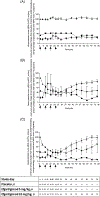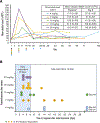Novel therapeutics and future directions for refractory immune thrombocytopenia
- PMID: 37735554
- PMCID: PMC11101754
- DOI: 10.1111/bjh.19078
Novel therapeutics and future directions for refractory immune thrombocytopenia
Abstract
Immune thrombocytopenia (ITP) is an autoimmune bleeding disorder affecting approximately 1 in 20 000 people. While most patients with ITP are successfully managed with the current set of standard and approved therapeutics, patients who cannot be adequately managed with these therapies, considered to have refractory ITP, are not uncommon. Therefore, there remains an ongoing need for novel therapeutics and drug development in ITP. Several agents exploiting novel targets and mechanisms in ITP are presently under clinical development, with trials primarily recruiting heavily pretreated patients and those with otherwise refractory disease. Such agents include the neonatal Fc receptor antagonist efgartigimod, the Bruton tyrosine kinase inhibitor rilzabrutinib, the complement inhibitors sutimlimab and iptacopan and anti-CD38 monoclonal antibodies such as daratumumab and mezagitamab, among others. Each of these agents exploits therapeutic targets or other aspects of ITP pathophysiology currently not targeted by the existing approved agents (thrombopoietin receptor agonists and fostamatinib). This manuscript offers an in-depth review of the current available data for novel therapeutics in ITP presently undergoing phase 2 or 3 studies in patients with heavily pretreated or refractory ITP. It additionally highlights the future directions for drug development in refractory ITP, including discussion of innovative clinical trial designs, health-related quality of life as an indispensable clinical trial end-point and balancing potential toxicities of drugs with their potential benefits in a bleeding disorder in which few patients suffer life-threatening bleeding.
Keywords: daratumumab; efgartigimod; immune thrombocytopenia; iptacopan; mezagitamab; platelets; refractory; rilzabrutinib; rozanolixizumab; sutimlimab; umbrella trials.
© 2023 British Society for Haematology and John Wiley & Sons Ltd.
Conflict of interest statement
Figures







Similar articles
-
[New drugs for the treatment of primary immune thrombocytopenia].Rinsho Ketsueki. 2024;65(9):1101-1105. doi: 10.11406/rinketsu.65.1101. Rinsho Ketsueki. 2024. PMID: 39358266 Japanese.
-
Rilzabrutinib for the Treatment of Immune Thrombocytopenia.Eur J Haematol. 2025 Jul;115(1):4-15. doi: 10.1111/ejh.14425. Epub 2025 Apr 13. Eur J Haematol. 2025. PMID: 40222822 Free PMC article. Review.
-
Changing Paradigms in ITP Management: Newer Tools for an Old Disease.Transfus Med Rev. 2022 Oct;36(4):188-194. doi: 10.1016/j.tmrv.2022.08.003. Epub 2022 Sep 14. Transfus Med Rev. 2022. PMID: 36273934 Free PMC article. Review.
-
Investigational drugs for immune thrombocytopenia.Expert Opin Investig Drugs. 2022 Jul;31(7):715-727. doi: 10.1080/13543784.2022.2075340. Epub 2022 May 11. Expert Opin Investig Drugs. 2022. PMID: 35531637
-
Novel therapies for immune thrombocytopenia.Br J Haematol. 2022 Mar;196(6):1311-1328. doi: 10.1111/bjh.17872. Epub 2021 Oct 5. Br J Haematol. 2022. PMID: 34611885 Review.
Cited by
-
Current state and potential applications of neonatal Fc receptor (FcRn) inhibitors in hematologic conditions.Am J Hematol. 2024 Dec;99(12):2351-2366. doi: 10.1002/ajh.27487. Epub 2024 Sep 26. Am J Hematol. 2024. PMID: 39324647 Review.
-
Microbe-immune interactions: new perspectives on coagulation deficiencies, purpura, and other hemorrhagic conditions under the regulation of the gut microbiota.Front Immunol. 2024 Oct 8;15:1461221. doi: 10.3389/fimmu.2024.1461221. eCollection 2024. Front Immunol. 2024. PMID: 39439804 Free PMC article.
-
Efficacy and safety of belimumab versus rituximab for refractory immune thrombocytopenia in patients with connective tissue disease.Lupus Sci Med. 2025 May 12;12(1):e001501. doi: 10.1136/lupus-2025-001501. Lupus Sci Med. 2025. PMID: 40355343 Free PMC article.
-
Impact of Thrombopoietin Receptor Agonists on Pathophysiology of Pediatric Immune Thrombocytopenia.Curr Issues Mol Biol. 2025 Jan 18;47(1):65. doi: 10.3390/cimb47010065. Curr Issues Mol Biol. 2025. PMID: 39852180 Free PMC article. Review.
-
Clinical characteristic of isolated thrombocytopenia in patients with bone marrow failure-related germline variants: a retrospective study from a single centre.Ann Med. 2025 Dec;57(1):2523560. doi: 10.1080/07853890.2025.2523560. Epub 2025 Jun 26. Ann Med. 2025. PMID: 40574285 Free PMC article.
References
-
- Al-Samkari H, Kuter DJ. Immune Thrombocytopenia in Adults: Modern Approaches to Diagnosis and Treatment. Semin Thromb Hemost. 2020;46(3):275–88. - PubMed
Publication types
MeSH terms
Substances
Grants and funding
LinkOut - more resources
Full Text Sources
Research Materials

